

Neil Casini interview
By Ross Sillifant
(2014)

Q: Neil, many thanks for partaking in this interview, could you please introduce yourself to our readership.
Neil Casini:
My name is Neil Casini. I currently part own and run Light
Pillar Software Ltd with my very talented friend Gareth Clarke. Light Pillar specialize in iOS and Mac OS apps; whilst we both wear a
designer’s cap, I specialize in the graphics and Gareth specializes in the code.
Prior to this career change, I worked exclusively in the video games industry
for about 20 years.
It all started in July 1994 (I was
21 at the time) where I set up my own business with a few like-minded friends.
After a few name
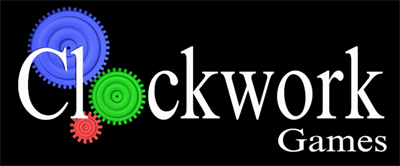 changes,
we settled on Clockwork Games and enjoyed 7 years of naivety and creative
freedom. In November of 2001 we actually became
a victim of the industry’s naivety and along with
many other developers, we had to close our doors. It was like the video
game
equivalent of the dot com bubble bursting in 2000
with many large publishers running out of money and cutting costs wherever they
could, dropping developers left right and
centre.
changes,
we settled on Clockwork Games and enjoyed 7 years of naivety and creative
freedom. In November of 2001 we actually became
a victim of the industry’s naivety and along with
many other developers, we had to close our doors. It was like the video
game
equivalent of the dot com bubble bursting in 2000
with many large publishers running out of money and cutting costs wherever they
could, dropping developers left right and
centre.
It was a bitter pill to swallow as we could not afford to continue self-funded.
So we settled the last of our financial commitments with our staff and bills
etc, and with a final farewell, spent the
last £50 down at the pub. This resulted in a move to Eurocom where I
enjoyed 11 roller-coaster years until it’s sad demise in December of 2012.
Q: I'd very much like to put a few questions to you regarding Vanishing Point (PS1 and DC) as that's for myself and I'm sure many others, one of your flagship games, so for starters, could you tell us a little about how the game came about? The racing genre was very over-crowded on the Playstation and you were I believe a self-funded company at the time, it must have been very risky trying to break into the market and this was quite a gamble, in hindsight, did it pay off?
Neil Casini:
Ah… Vanishing Point. I could talk about this for days! :) VP was
an attempt to realize a dream. I remember very clearly the brief we set upon
ourselves; build a racing game like it is a conversion of an arcade game that
could have existed. We wanted arcade visuals with the beautiful simplicity of
man and machine against the track and the clock.
I think the idea came about whilst working on Speedster. One day, just for a
laugh, we took the top down camera and put it behind the car to see what it
would look like. Given that Speedster’s tracks were built knowing that you
couldn’t see to the horizon, we could spend all of our rendering budget on just
a few meters of road. Knowing this, we didn’t expect the game to run at all and
the PlayStation would just grind to a halt. It didn’t. Holy s**t we all thought! And with that, the seed was planted in our mind. Actually, it was more like an
itch that needed to be scratched; we wanted to know just what we could achieve
and see if we could compete against the big boys with a proper racing game.
So, when Speedster was finished with Psygnosis, we had enough money to go it
alone and decouple ourselves from all the restrictions and pressures of working
with a publisher to have a go at scratching this itch. Yes, it was a risk but we
were young and thought we had nothing to lose.
Did it pay off? I think it would have if we were able to continue development
past the first game. You see, VP was just a proof of concept to us and hopefully
the first of long line of continuously refined technology. We had lofty goals.
We were in it for the long-term.
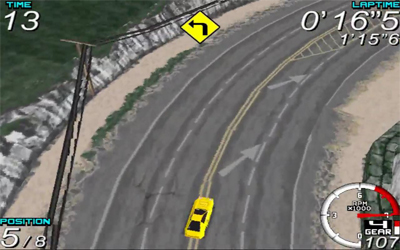
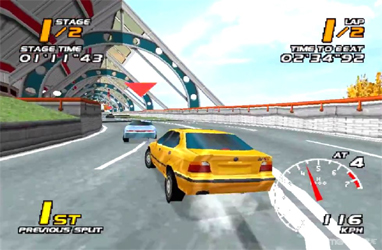
Speedster (LEFT); Vanishing Point (RIGHT)
Q: From a technical point of view, Vanishing Point really seemed designed to push the Playstation, let alone the Dreamcast, with no pop-up or fogging present and yet the game still boasted superb physics and A.I. Could you talk us through a little of the process of designing the game from a technical point of view, which area's were seen as key and how did you carry out what must have been quite a balancing act to try and ensure that whilst the game ticked the technical achievement boxes, it was also as much fun to play as possible. Just how far do you think you pushed the Playstation and how much untapped power do you think you had left in the Dreamcast?
Neil Casini:
It all started with that initial test where we change the camera
in Speedster to a typical 1st/3rd person view. When we got chance to
revisit the rendering engine we realized there were a lot of optimizations that
we could make to improve things a LOT. Enthused by the possibilities, we
set about building a proper track with all of the polygons evenly distributed
for looking towards the horizon instead of from overhead. It was during
these initial tests that the name was born. We were amazed with the amount
of track we could draw and one of us said; “It’s practically drawing to the
vanishing point!” - the point where two parallel lines meet in the distance.
And that was it, the name was set in stone. At first, people put two and
two together and asked if it was a game based on the 1971 movie of the same
name. That was a cool coincidence but no, it was based on a nerdy, yet
natural occurrence. It also let us have a little dig at all those other
racers that did suffer from fogging or pop-up! :)
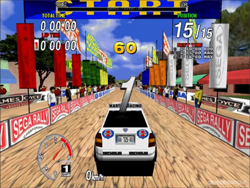
Anyway, after much R&D we finalized our metrics and began building tracks to the
specification required by our new rendering engine. It was this point we
turned to the vehicle handling…
At the time, there was only 1 king of simulated but accessible handling; Sega
Rally Championship. This game was the benchmark that we wanted to
beat. The cars looked so convincing in how they moved (I could watch the
replay intros for hours!) and for anyone who knew how to drive, you got
predictable results from the game which felt ‘real’. We knew that the
micro-machines inspired driving model from Speedster just wouldn’t cut it.
For a start, it was just a bicycle model; just a front and rear axle with body
roll and drifting that was proportional to the amount of steering - more than
adequate for a top-down racer. Looking back, the decision we were about to
take was both a blessing and a curse.
So realizing that we needed a proper vehicle model we decided to enroll
specialists on the subject. We knew that the leading minds in the UK were
based at Loughborough University’s Aeronautical and Automotive department -
these guys were technical advisers to many of the big name vehicle manufacturers
and motor racing teams at the time (and possibly still are). When we got
in touch explaining what we wanted to achieve they were intrigued and very
excited about the prospect as they’d never been involved in a proper simulation
for a game before. We were excited at their excitement and set up a
initial meeting with high hopes for what might be possible.
At this meeting we showed them Sega Rally and made it clear that this was the
benchmark we wanted to beat. To our amazement, they said it (Rally) was
pretty convincing but actually quite basic! We just assumed that Sega had
used real physics and to a degree they had. But the way they could tell
what was under Sega’s bonnet (or rather, what wasn’t) we knew that these guys
had the potential to give us a physics model light years ahead of the
competition. To say we were excited was an understatement - could we be
the first game to utilize the expertise of bona fide vehicle dynamicists?
Maybe…
So, work got under way creating a specification; a list of things the
PlayStation could and couldn’t do. The main issue was that the CPU only
supported 32-bit integer numbers; this meant we couldn’t have decimal places and
for real accuracy you need LOTS of decimal places. “No problem”, they
said. “We’ll simulate floating point maths”. In short, they would
take this 32 digit number and decide where they wanted the decimal point on the
fly. Say, for example, you wanted to express Pi, you only need 1 digit
before the decimal point as the bulk of the number is after the decimal point.
So in this case, we could express Pi to an accuracy of 31 decimal places - more
than enough to be accurate to measure the minute displacement of suspension for
example. Conversely, we could put the decimal point at the other end and have
really big numbers where the number of decimal places made no difference - like
acceleration, for example. That’s probably not a very accurate explanation
of how it actually worked but I’m sure you get the idea. :)
What they then set about doing was to create a physics engine that simulated to
industry standards, all the mathematical complexities of how a car actually
handles. And because they were supreme in their understanding of the
subject, they didn’t waste time simulating systems that didn’t matter in terms
of a game. The really big point here is that they knew exactly what
systems DID matter. Some months went by and after lots of collaboration we
were invited down to see the first fruits of the physics. They worked with
some computational software called Mathmatica so prior to this
demonstration, we loaned them a dev kit and built them a special tool that used
the data from Mathematica to position a car on screen. Think of it as a
real-time movie player that moved the wheels, suspension and body of the car to
visually represent and validate the numbers that Mathmatica was spitting out.
Because the physics simulation was real, it needed real data. This meant
if you had all the relevant data from your own car (engine power, gear ratios,
final drive ratio, mass, centre of gravity, dimensions, wheel size, tire size
and profile, spring length and stiffness, damping etc, etc), you could just feed
these numbers directly into the simulation and you would get an accurate digital
version that behaved EXACTLY the same as the real thing. We were skeptical
that such a thing was possible but went down ready to be disappointed but
hopeful these vehicle dynamicists really were as good as we hoped!
They explained that they had been doing some testing on a Ford Mondeo and had
all the relevant numbers to plug into the simulation. They also simulated
accelerator, steering and brake inputs based on data recorded from an actual
test maneuver at the MIRA test track in Warwickshire; which incidentally was a
simple handbrake turn. Our jaws hit the flaw when we saw it. Despite
the low resolution display and crude test model (I believe it was actually a red
pickup truck) it just looked REAL. They then showed us another test of
dropping the car from a height with some pitch, roll and momentum. The way
it hit the ground and rolled over - the suspension compressing and launching the
car into another roll - was just amazing. Nothing, NOTHING, held a candle
to what we were looking at. These seem like simple tests now but back then
it truly was astonishing to behold. It was akin to the difference between
an hand animated walk and a motion captured walk; one looks okay but the other
one looks real because it is real. Straight away we could imagine cars
racing around our tracks reacting to all the undulations and collisions and we
couldn’t wait to play it.
This was a good time to start converting the Mathmatica code into C, which was
undertaken by our lead coder, Robert Rawson. Gradually all of the
vehicle handling was converted over and the day we picked up a controller and
actually drove a car (just on a flat plane to begin with) was amazing.
YES! This is going to be awesome! After this came car-to-environment
collisions so we could drive it around our tracks. Initially this was
dreadful and the cars didn’t drive at all. We quickly realized that there
wasn’t enough resolution in the polygon mesh to provide a realistic driving
surface. Polygons on the road were equivalent to 4m square so you couldn't
create small bumps. A small bump in our eyes - modeled over 2 road
polygons - was huge for the physics! It was like trying to drive a Ferrari
over a BMX track - impossible! So, we had to flatten everything down and
reduce the exaggeration down to a scale that was compatible with the vehicle
physics.
When all this was done it was time to think about the AI for the other cars.
At this point we measured the performance just to see what was available.
We’d decided to lock the PlayStation version to 30fps to give us a fighting
chance of running everything but was surprised to find more processing available
than we thought. So, the physics "boffins" took the vehicle physics and
stripped it down so there was just enough to drive a computer controlled driver.
This give us AI that looked comparable to the player which was really important
to us - the last thing we wanted was drone driving around welded to a spline.
We gave them awareness of the player, each other and the racing line. They
knew what speed they could take corners and with some basic ‘personality’
settings, we could drop them into the world and just let them do their best to
drive around the course as fast as their car would allow them. The results
were as organic as we could have hoped for and it created really unpredictable
races that always kept you alert. And because all the collisions were real
physics, you couldn’t use other cars as braking barriers to get around corners.
No, you had to respect both the course and the AI otherwise you’d pay the
penalty.
Overall, the PlayStation was pretty much maxed out. We know this because
the simulations are real and cannot be cheated. Traditionally, you can
always find a way to optimize or cheat to get the same results but not here.
Yes, we were damn pleased with what we’d achieved until that is, we converted it
to Dreamcast. Boy… it was like going from black and white to color TV for
the first time. The first thing you notice is the resolution; especially
through a VGA box. Then you notice the speed; the PlayStation was so
tightly optimized it ran at 60fps on the Dreamcast. Someone then asked an
interesting question… what if you ran the simulation with full floating point
maths? This is where Martin Hall took over from Rob’s code and
converted it (with the help of Loughborough) to floating point. It was so
silky smooth that it made the PlayStation look decidedly clunky - the cars
didn’t handle quite as well, collisions not as convincingly resolved. The
Dreamcast provided the speed and solidity that elevated the game to a new level.
You ask about untapped power on the Dreamcast version? As we didn’t have
time to do anything other than double the texture resolution, I’d guess there
was at least 40% more in the tank. Given time, I think we could have given
the visuals a make-over that would have delivered on the ‘Arcade Experience’
that was the underlying motivation right from the beginning. In that
moment we knew what Vanishing Point 2 was going to be.
Q: Would it be fair to say you and your team at Clockwork Games were huge fans of SEGA's racing games and where possible homage to them was paid in Vanishing Point? Which were your favorite Sega racers and which influences from them made it into Vanishing point and why?
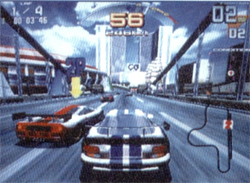 Neil Casini:
Absolutely! Sega were the best in our eyes. They were
the team we wanted to be and tried to emulate. I think if we had the
opportunity to build Vanishing Point 2, we might have got close but that Sega
magic is hard to quantify, never mind replicate. There were 2 Sega games
that heavily influenced us; Sega Rally for the vehicle handling (as I’ve
already mentioned) and Scud Race for the track design and overall sense
of occasion. We probably missed the mark on the latter but I think that
was because we had to build more tracks that you can get away with in an arcade
game and of course, the physics meant we had to tone things down a bit. I
remember the entire team spending a lot of time down at the arcade soaking in as
much information as we could in our attempt to understand just what makes a Sega
racer what it is. I believe it’s things like power sliding around a corner
as a jumbo jet comes in to land right over head, you know… those ‘wow’ moments
that you only get a glimpse of because your eyes are welded to the road ahead.
They make a big difference.
Neil Casini:
Absolutely! Sega were the best in our eyes. They were
the team we wanted to be and tried to emulate. I think if we had the
opportunity to build Vanishing Point 2, we might have got close but that Sega
magic is hard to quantify, never mind replicate. There were 2 Sega games
that heavily influenced us; Sega Rally for the vehicle handling (as I’ve
already mentioned) and Scud Race for the track design and overall sense
of occasion. We probably missed the mark on the latter but I think that
was because we had to build more tracks that you can get away with in an arcade
game and of course, the physics meant we had to tone things down a bit. I
remember the entire team spending a lot of time down at the arcade soaking in as
much information as we could in our attempt to understand just what makes a Sega
racer what it is. I believe it’s things like power sliding around a corner
as a jumbo jet comes in to land right over head, you know… those ‘wow’ moments
that you only get a glimpse of because your eyes are welded to the road ahead.
They make a big difference.
Q: Vanishing Point (sadly) was your 1 and only Dreamcast game, what were your thoughts on the hardware, in terms of how easy it was to develop for and how did it compare to later systems like the PS2 and Xbox, and also how Sega handled it? Do you think if things had been different, the Dreamcast had enough 'grunt' to go the distance with Playstation 2 and what would you ideally have liked to have written for it? I could just see you guys doing a cracking conversion of say Scud Race on Dreamcast for Sega or a Retro pack with things like Outrun, Power Drift, etc on it. Would you have loved to of done more on the Dreamcast? And as a developer, did it frustrate you to see the Dreamcast struggle at retail against the perceived power of the Playstation 2?
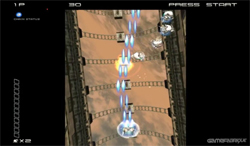 Neil Casini:
We loved the hardware. As do many other developers.
It was the first console to really attempt the repurposing of tried and tested
PC hardware internals. After the Saturn, I guess Sega has been stung with
overly complex hardware and wanted to make
amends. The only mistake they made was
Windows CE. You didn’t actually need to use this as you could hit the
hardware directly (you can tell which games use WinCE and those that don’t) so
it had the access and freedom that programmers enjoy on hardware that is
familiar. This is why Martin had the job of converting Vanishing Point to
Dreamcast as he was a very experienced PC coder. Personally, I think the
Dreamcast could have easily competed with the PS2. As I said earlier, it’s
amazing what tricks coders find to keep achieving what was previously regarded
impossible. The Dreamcast’s output was of extremely high quality; in terms
of how nicely it rendered color, contrast and clarity. Just look at the
first Soul Caliber - it still looks gorgeous even today.
Neil Casini:
We loved the hardware. As do many other developers.
It was the first console to really attempt the repurposing of tried and tested
PC hardware internals. After the Saturn, I guess Sega has been stung with
overly complex hardware and wanted to make
amends. The only mistake they made was
Windows CE. You didn’t actually need to use this as you could hit the
hardware directly (you can tell which games use WinCE and those that don’t) so
it had the access and freedom that programmers enjoy on hardware that is
familiar. This is why Martin had the job of converting Vanishing Point to
Dreamcast as he was a very experienced PC coder. Personally, I think the
Dreamcast could have easily competed with the PS2. As I said earlier, it’s
amazing what tricks coders find to keep achieving what was previously regarded
impossible. The Dreamcast’s output was of extremely high quality; in terms
of how nicely it rendered color, contrast and clarity. Just look at the
first Soul Caliber - it still looks gorgeous even today.
Ideally, we’d have written Vanishing Point 2 as a Dreamcast exclusive with Sega
as our publisher. That would have been amazing! A close second would
be to convert Scud Race. Thirdly, I would have loved to use our technology
to create a sequel to Sega Rally instead of the horrible WinCE version they
released. Yes, it did frustrate me to see a genuinely great piece of
hardware get instantly relegated to second place. It was and still is a
great machine. I still have mine for playing Vanishing Point and
Ikaruga :)
Q: How do you feel Vanishing Point compared to games like F355 Challenge, Gran T, Sega Rally, Ridge Racer, MSR, etc? If you could go back and re-do the game, what would you address and why?
Neil Casini:
Honestly, I think it wasn’t as well rounded as any of these games
because in many respects Vanishing Point was released before it was finished.
This is in part due to the failing relationship with our publisher. It was
also in part due to the technology the game was based on. If you recall, I
mentioned earlier that the decision to go with a real physics solution was to be
both a blessing and a curse?
The curse is that you had to feed the thing real data. At the time, it
didn’t even occur to us that we wouldn’t be able to get the data. After
all, games like Gran Turismo had real cars with supposedly real
specifications so we just assumed it would be easy. We were SO wrong.
We had a hard time getting manufacturers to give us the data we were requesting.
Maybe they were nervous of divulging such information? Maybe we couldn’t
put enough dollars on the table to persuade them? Who knows for certain.
But what was certain, was the 150 variable vehicle physics model running with
almost half of the numbers set to zero or just a best guess. The
technology became a victim of it’s own supremacy in that you couldn’t just plug
any old numbers into it. This is why certain cars felt more ‘together’
than others - these have more data plugged in. Of course, we didn’t
advertise this at the time but the truth is the game didn’t show off what the
physics could really do. All because we didn’t have the data.
So, in answer to your question, I would go back and ensure that we secured the
data we needed by demonstrating the potential to the manufacturers and showing
them just how good their cars could feel. Again, this was something that
we knew we wanted to address in Vanishing Point 2.
Q: Moving onto another of your racers, this time Speedster (which was known as Rush Hour in the USA?), this seemed to have yet again all the hallmarks of your eye for detail and technical excellence: rock solid frame rate, even in 2P mode, no pop-up or polygon break-up etc, but took the unusual (for that generation) view point of a top-down racer. Was the reason for the viewpoint a technical one, or did you perhaps feel the Playstation badly needed a classic top down racer, or both?
Neil Casini: The reason for the viewpoint was because we wanted to create a racer with a Micro Machines feel, but with high fidelity 3D graphics. There was nothing of this nature on the PlayStation and we felt it would be a good way to get used to racing game tech without having to compete against traditional racers (Ridge Racer et al). What we didn’t know is that Codemasters was working on Micro Machines 3D (or whatever the actual name was) and they released it before us. It was just bad timing and we couldn’t compete with the brand. Without Micro Machines, we might have stood out a bit more.
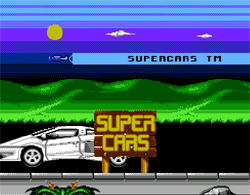 Q:
Critics felt that whilst Playstation Speedster looked the part, it lacked a
sense of speed (ironically) and could have done with some epic crashes etc to
inject some excitement into the game, others, talked of not getting on with the
handling in Vanishing Point, so my question is, as a developer who's poured so
much into a game, how did you and your team react to both critical and public
feedback to your games? Did you take constructive comments on-board for
future projects? After 20 years in the industry, how thick a skin have
you grown? I guess you had to soon learn that you could never please all
the people, all the time, but which mattered more - customer feedback, or
reviews in the press?
Q:
Critics felt that whilst Playstation Speedster looked the part, it lacked a
sense of speed (ironically) and could have done with some epic crashes etc to
inject some excitement into the game, others, talked of not getting on with the
handling in Vanishing Point, so my question is, as a developer who's poured so
much into a game, how did you and your team react to both critical and public
feedback to your games? Did you take constructive comments on-board for
future projects? After 20 years in the industry, how thick a skin have
you grown? I guess you had to soon learn that you could never please all
the people, all the time, but which mattered more - customer feedback, or
reviews in the press?
Neil Casini:
Yes, we were never happy with the names that were given; the game
was never about speed and you weren’t driving through rush hour traffic either.
I guess it’s an example of marketing getting it wrong. But, in their
defense, we didn’t know what to call it
either! As Speedster was still only our second game and our first venture
into racing, we were very conscious of what people might say because as everyone
in the industry knows, you are only as good as your last game and we wanted to
make a good impression.
Although it was disappointing to receive the criticism, we realized that people
didn’t really want top down racers - maybe in the face of pushing the genre
forward, it was perceived as a step backwards? We thought a 3D Super
Cars would be cool. I guess you get it wrong sometimes.
Whilst the reviews were disappointing, I think we’d already mentally moved on to
concentrate on Vanishing Point - a proper racer. Vanishing Point was the
game we poured our heart and soul into and critical feedback would have hurt a
lot but as we knew Vanishing Point was a long term project, we believed that if
the feedback was as critical as our own, we knew we were on the right track for
delivering something truly special on the sequel.
I don’t believe it’s about getting thick skinned. It’s about your
involvement and position in a team. If a game is your baby (say, like
Dead Space: Extraction) criticism can really hurt to a point where you can
take it personally. On the other hand, if you are only a small part of a
project (say, like the Batmobile sections on Batman Begins) you aren’t as
emotionally invested and as such, are much more resilient. Of course you
want every game to do well in the best interests of running a business, but
truth be told, it can be easy to point fingers elsewhere. Everyone always
thinks they could have done a better job; this includes staff as well as gamers
and the press. But it’s not always as simple as people think. Behind
the scenes there is so much red tape; licensing restrictions,
commercial/financial restrictions, internal design conflicts etc, etc.
I’ll give you two examples. We’d be reading criticism for Athens 2004
shouting at the review “We wanted to do that but couldn’t!”. In this case,
a lot of our fun ‘gamer-centric’ ideas were rejected by the IOC (International
Olympic Committee) because they conflicted against Olympic Ideals. Gamers
don’t give two hoots about Olympic Ideals. Secondly, for The Mummy:
Tomb of the Dragon Emperor, our deadline for finishing the game was before
they actually finished the film! Certain sequences in the game were based
on parts of the movie that they hadn’t filmed yet or had placeholder CGI effects
and characters. This is a legitimate excuse but gamers don’t care about
such issues. And why should they? It’s a frustrating side of
licensed gaming that can completely derail your project.
On your question about which opinions mattered most, that depends on who you
are. If you are a developer then it all about the gamers. If you are
a publisher, then it’s all about the reviews and the Metacritic score.
That’s not to say developers don’t care about official recognition, because we
do. It’s just that in my opinion, no review beats seeing people losing
themselves in something you created. Vanishing Point may have had mixed
reviews but the online servers were packed and some of the racing was
incredible. It made it all worth while.
Q: Were you ever aware certain UK magazines once referred to Clockwork Games as the developer who were 'pretending to be DMA’? If so, how did that go down with the team?
Neil Casini: Really? I never knew that. I’m not sure if that’s good or bad?! ;)
Q: Moving away from racers, lets look at 3D Lemmings. Taking such an established 2D classic and turning it into 3D must have been a mammoth undertaking. Could you talk us through a little of the thinking behind it, difficulties encountered etc in terms of ensuring basics like the controls and camera 'worked' well (lot of 3D games I played on PS1 were blighted by awful camera system, sloppy controls etc) and how on earth did you go about ensuring the 'charm' of a 2D game made it into a 3D environment? The game must have been a very daunting task and how does level design differ when designing a game for a 3D environment?
Neil Casini:
When I think about 3D Lemmings, the standout memory was trying to
get to sleep at night - all I could see on the back of my eyelids was bloody
lemmings! All the lemmings were rendered by my good friend Robert
Matthews and I had the joyful task of converting each frame into a specific
16 color palette and cleaning up any stray pixels and anti-aliasing artifacts.
There were about 1500 frames to wade through. It was definitely a labor of
love!
3D Lemmings actually started life as a puzzle game that was created by James
Thomas and Martin Hall working under the name Lunatic Software.
They were already working for Psygnosis (they did a fantastic job of porting
Wiz’n’Liz to the Amiga) and I believe during a code review, someone said
could this be reworked to make lemmings in 3D? The idea stuck and the
project was green-lit. At the time, I was at college and by chance, a
customer of my dad’s barber shop said he had a friend (James Thomas) who was
looking for an artist. We met up and our discussions led us to forming
Clockwork Games. We were: James Thomas (PC code), Martin Hall (PC code),
Robert Rawson (PlayStation code), Andrew Brechin (PlayStation
code), Robert Mathews (3D character modeling and animation), and me (graphics
and texturing). We all got involved in building levels - which was
mind-bending good fun!
The key aspect of 3D Lemmings was coming up with the 90-degree blocker.
This skill would let us direct lemmings left or right into the screen and opened
up that all important 3rd dimension. The technicalities of the game
weren’t that complicated actually. Because lemmings only ever walked in a
straight line, they were still effectively restricted to a 2D plane so you could
position the camera side on and play the game in exactly the same way as the 2D
version. The only difference was having to manage the camera an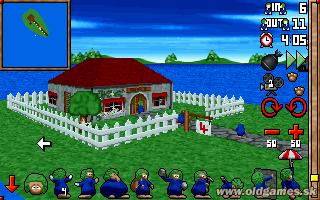 d
switch between the various 2D planes as you followed the lemmings around the
level. Because of this, you could just strafe the camera around the level
and always be in control of the lemmings, with just the occasion frantic action
of rotating the camera. Plus, of course,
you could put the camera inside the head of a lemming for a lemming’s eye view
and then just jump back out when you’d traveled
to a bit of the level that needed your attention. Pretty straight forward
really.
d
switch between the various 2D planes as you followed the lemmings around the
level. Because of this, you could just strafe the camera around the level
and always be in control of the lemmings, with just the occasion frantic action
of rotating the camera. Plus, of course,
you could put the camera inside the head of a lemming for a lemming’s eye view
and then just jump back out when you’d traveled
to a bit of the level that needed your attention. Pretty straight forward
really.
Level design was by far the most complicated aspect. It was amazing how
that extra dimension could either screw up an idea or indeed, transport it to a
level of devious cruelty! It didn’t take long for us to get into the swing
of things and we were soon banging out levels. I think Andrew was the most
twisted of all of us - his levels were just insane!
For me, 3D was a huge learning curve but the editor that was built into the game
was really great and in fact, each block was just like a large pixel; there was
no intricate detail that we have nowadays - so it was pretty easy to get to
grips with. You just painted blocks down into the world, set up the number
of lemmings and what skills were available and hit the play button.
Looking back, the editor should have been released to encourage an online
community but I don’t think anyone realized it would be as successful as it went
on to be.
Q: How much 'freedom' did you and the team get with Batman Begins for Electronic Arts (a title I still dig out and play to this day on Xbox)? Personally I felt game was a mixed bag - very nice looking, atmospheric, and captured the 'feel' of the movie very well (I loved the Batmobile sections, even if they were far from original), but I felt a little let down by the main sections of the game as they were too linear, combat seemed restricted (the game would only let me use my gadgets at certain times. I'm Batman. I want to dish it out as/when I want to). The stealth worked fine, but I'd have loved the fear aspect of the game to be taken much further. Were you working to strict guidelines?
Neil Casini:
Batman Begins wasn’t my project and I only came onboard about
half way through development. Due to my experience with Vanishing Point, I
was asked to manage a small team to create the Batmobile sections - so I’m glad
to hear you loved these! The game was heavily controlled by EA and we
pretty much did what they asked us to do. I wasn’t involved in any of the
3rd-person side of the game so can’t really comment on the decisions that were
made but I share your frustrations. For the Batmobile sections, the brief
was to replicate Burnout; with the all the insane speed and takedowns.
We were really up against it, actually. Initially we thought just two
sections would be quite easy, but EA wanted each section to last about 10
minutes. On full boost, the Batmobile traveled about 200mph. So for
a section to last 10 minutes, we had to build about 30 miles of track! All
of a sudden we had a mountain to climb. I remember the levels really
testing the game engine to the max but I think they turned out pretty well and
were a welcome change to the slow pace of the main game. In actual fact,
some of the takedown mechanics and ideas were borrowed for the next version of
Burnout, so I was pretty pleased to hear that!
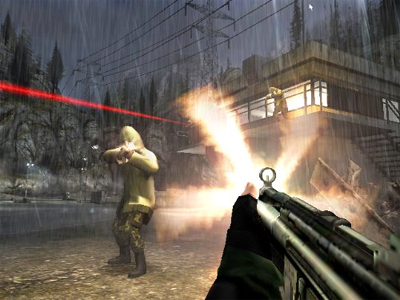 Q:
Moving onto GoldenEye 007, do you feel this game was more 'at home’ on
the Wii, where it faced less competition? The PS3/360 market seemed to be
in danger of collapsing under its own weight in FPS. Game felt solid
enough for myself on PS3, though I've never managed to complete last section as
it seems tad too scripted, and again, as with Batman Begins, just how much freedom
did you have when making the game? Also speaking as a developer, would you
rather develop original titles? Or sometimes is it easier
to have guidelines to work to, so you can focus within those and have less
headaches as a result?
Q:
Moving onto GoldenEye 007, do you feel this game was more 'at home’ on
the Wii, where it faced less competition? The PS3/360 market seemed to be
in danger of collapsing under its own weight in FPS. Game felt solid
enough for myself on PS3, though I've never managed to complete last section as
it seems tad too scripted, and again, as with Batman Begins, just how much freedom
did you have when making the game? Also speaking as a developer, would you
rather develop original titles? Or sometimes is it easier
to have guidelines to work to, so you can focus within those and have less
headaches as a result?
Neil Casini:
I couldn’t imagine it launching on any other platform; Nintendo
was the home of the N64 GoldenEye we all remember so fondly so it just felt
‘right’ to launch on the Wii. And as you rightly mention, there was the
commercial benefits of a less crowded market.
I was working on another project whilst the Wii version was in development and
the PS3/X360 versions were just a HD remake - so it was just a case of enhancing
the existing game. Plus, we didn’t want to mess with the formula as it was
well received the first time around. Or course, Bond has his own fair
share of frustrating licensing restrictions just as with Batman. In both
cases, it’s about portraying the character in a manner consistent with the rules
already defined by license; Bond can do this, but he can’t do that. These
are the rules that you have to design around and they can sometimes get in the
way of gameplay.
Guidelines are fine so long as they remain in the same ballpark - there nothing
worse than working with constantly moving goalposts. For me, I’d take an
original title any day but you’ve got to be confident of getting a publisher to
sign it up. Not an easy task these days.
Q: Could you talk us through just how Dead Space Extraction came about? It worked superbly as an on-rails shooter, dripping with atmosphere, superb plot, break neck pace, and a real feeling of paranoia. It was by and large a far superior Dead Space game than Dead Space II in my humble opinion. Was it built from the ground up, or were you just asked make an on-rails shooter for the Wii, based on Dead Space, as publishers thought the genre more suited to the Wii?
Neil Casini:
Many thanks for your kind comments. I think we pushed the
envelope on every level; characters, story, emotion, game play, graphics and
sound. There really wasn’t anything else we could have thrown at the
project. It is my most proud achievement.
Originally, it was meant to be an on-rails shooter very similar to Sega’s The
House of the Dead; a very loose story, no cut-scenes as such… just shoot,
shoot, shoot. This is until we delivered our first vertical slice (a
snapshot of what the final game could look like so execs can understand what
they are getting and officially green light the completion of the project).
Based on what they saw, EA elevated the status to AAA over night and from that
point on, everything changed.
I worked very closely with my co-Director at Light Pillar, who back then was my
Lead Engineer. Gareth had a ‘thing’ for making great tools and he built
this fantastic spline-based camera editor that worked inside the game. Our
first attempts of guiding the camera through the environment were authored in
Maya, but the export process was far too slow and it made the development
pipeline a chore. With the editor in the game, you could make changes on
the fly. And it wasn’t just the camera path. You could set the
emotional state of the character which would adjust how the camera behaved.
We motion captured lots of movement based on people walking and running with
different emotional states; from a slow, cautious creep to a frantic ‘get me the
f**k out of here’ sprint. This motion capture data was added to the camera
to properly simulate the emotion through appropriate camera movement. It
worked brilliantly. We’d taken the typical FPS generic camera ‘bob’ first
employed by Doom, to movement that looked so natura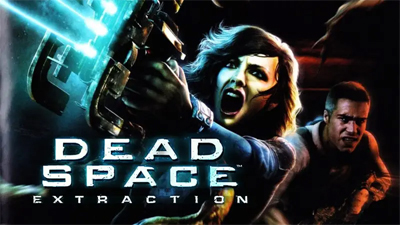 l,
it sucked you into the game world and made you feel like you were actually
there. This initial test spawned an entire R&D process to see just how far
we could take it and the guys in the motion capture department broke a lot of
new ground, most notably in facial animation
and overall acting believability. We built a portable camera rig so actors
could see the virtual environment that they were acting against and it really
helped them ‘get into the moment’. It really was an amazing time.
l,
it sucked you into the game world and made you feel like you were actually
there. This initial test spawned an entire R&D process to see just how far
we could take it and the guys in the motion capture department broke a lot of
new ground, most notably in facial animation
and overall acting believability. We built a portable camera rig so actors
could see the virtual environment that they were acting against and it really
helped them ‘get into the moment’. It really was an amazing time.
So with the camera delivering this new level of emersion, it was just begging to
be complemented with a proper story. And so everything changed. The
writer from the Dead Space graphic novels (Antony Johnston) was brought
in to write a brand new story that would take the player right up until the
start of Dead Space on the PS3 and X360. It was all super exciting.
The budget increased, to support the level of detail we were shooting for.
Unfortunately, all this increased expectation did pile on the pressure, and EX
execs would spend months at a time on site at Eurocom helping us build the game.
We knew it was something special, but we still had that coined phase in the back
of our minds… ‘on-rails shooter’. It was SO much more than an on-rails
shooter that we started calling it a guided FPS. People were skeptical,
but they soon changed their minds when they played it. Sure, it wasn’t for
everyone. Some people wished they could detach from the rail and go
exploring, but they are missing the point. This was probably the first
successful attempt at a interactive movie whereby you were taken on an emotional
roller coaster that you could not get off. You couldn’t hide or run away…
you were forced to keep moving on just like in a movie and the game was much
more intense and scary because of it.
It would have been nice to have the graphical prowess of the PS3 and X360 to
play with but I think visually it looks pretty damn impressive. There was
one thing that these two consoles would not have competed on, and that’s
control. This type of game needs a light gun and for that reason alone,
the Wii was the perfect platform.
Q: How did you approach the HD versions of GoldenEye and Dead Space for PS3? Was it a nightmare re-doing assets like texture maps, or was the process easy enough? Talking of the PS3, how did you find it, as a platform to work on? And did developing for the PS2 in the past help as that too was a difficult platform to code for?
Neil Casini:
I believe the HD version of GoldenEye was a proper remake in that
all the graphics were re-engineered to use shaders and all manner of next-gen
effects. As for DS:E on the PS3, this was mostly converted by just 2
people (although there was additional support from the central animation and
sound teams). A talented coder called Graeme Richardson handled all
of the engineering and I converted all of the graphics. There wasn’t the
time or budget to remake all the assets like in GoldenEye so it was just a case
of switching the resolution to HD and doubling all of the textures. I had
created all of the HUD for the Wii version in vector images so doubling up was
simple. And for the textures, as any well trained artist will tell you,
you always work on a high-resolution master image and scale down to the target.
So, it was just a matter of going through the original masters and exporting for
PS3. There were some textures that needed repainting but that was fine as
I was pretty familiar with Photoshop.
Working on consoles today isn’t like how it used to be. As a game team,
you aren’t exposed to the hardware anymore. You just interact with the
Engine and Middleware. From what I know, the PS3 was the harder cookie to
crack because of its complex architecture. Any performance gains it did
have over the X360 could not be fully exploited because the Engine and
Middleware needed to be cross platform compatible. It’s why multi format
games look pretty similar on any platform but exclusive titles can be tailored
to the platform and generally look better. So in answer to your question,
it didn’t really make much difference to us. I guess the main areas of
complexity (and headache) were the differences in RAM and the online multiplayer
protocols (PSN vs Xbox Live).
Q: We’ve talked about your released titles, but I always like to uncover the LOST games, so Neil, are there any games that we never saw from your good self, on any platform and if so, what became of them and why? Could you perhaps of been coding away on a Konix Multisystem or Atari Panther game perhaps or a C64 game that never saw the light of day? Does code exist for a long forgotten PS2 title perhaps? Anything would be great to read up on.
Neil Casini: There is one game that will be of particular interest to you and your readers. I worked on a prototype for a next-gen Contra. Eurocom was in talks with Konami and another internal team had made an attempt at a visual style, but it didn’t go anywhere, so they gave me a crack at it. I threw it all away (sorry lads!) and started from scratch, focusing in on the fundamental mechanics of a run’n’gun game. I decided to take inspiration from Geometry Wars and utilize a twin-stick control system whereby you steered your character with the left stick and aimed and fired your gun with the right stick. It had a semi-auto lock-on that meant you just pointed the stick towards the enemy and it would handle the vertical aiming for you. It meant that we could author the camera to keep the action on screen and always look dramatic while you just jumped around looking cool. We thought it was awesome, as did the Konami producer when he came to see the demo. Sadly, we didn’t get the contract. We were gutted. It’s a game that I’d still love to make one day.
Q: You're clearly a keen gamer, Neil, so may I ask if you ever took a side in the various computer and console 'wars' (C64 VS Speccy, ST Vs Amiga, MD VS SNES etc), and if so, what drew you to a particular platform and why? Or were you like many of us, someone who ended up with various computers and consoles, because you only cared for the exclusives or best versions of games? What would you class as your all time favorite platform, and why would that be?
Neil Casini:
Back in the day, I was a firm Amiga fan. In fact I still
am. I help run Amiga Demoscene Archive with a
friend, Wouter Derdeyn. I started out with the A500 Batman Pack which is where I
first learned DPaint. I then got an A1200 which was upgraded with an accelerator
card and internal HD. My favorite Amiga was my A4000T which I acquired during
the Clockwork Games years. It had a 060 CPU and a 64-Bit CyberVision graphics
card and was awesome! All the sprites, logos and textures from 3D Lemmings,
Speedster, Vanishing Point, and Harry Potter & the Chamber of Secrets were all
created on my Amiga using Brilliance 2.0. I still miss that software even today.
On the console front, my true passion was the Sega Saturn. You could say I was
obsessed with it. I’d trawl eBay collecting anything Japanese. I had 11 Japanese Saturns (all different model variants) and all manner of peripherals including
3D controllers, mice, keyboards, printers, modems, wireless controllers… I’d
also collected each of the very best and highly sought after games including
every vertical and horizontal shoot’em up available. I also had Neo Geos, PC
Engines, etc but the Saturn was the one that really gripped me. I’ve got
rid of most of them now, but I did keep a Saturn and a copy of Radiant Silvergun
- these will go with me to the grave.
Q: You've developed on so many platforms over the years. For our more technical based readership, could you shed some light on what hardware you used (with which software) when developing for consoles for example and which hardware companies supplied the most help in terms of support, tools, etc? Sega pre-Dreamcast era had a bad reputation here, Sony with PS2/PS3 had complex hardware but seemed to offer decent support to developers. How did Nintendo compare, when developing for the Wii for example?
Neil Casini:
To be honest with you, I always used to glaze over when it came
to the technical aspects of setting up the "SDK" (software development kit) and
integrating it with our own proprietary tools, so I won’t pretend to know how it
all worked as I’ll probably stitch myself up! But generally speaking, it
all starts with a special development version of the console. This can
look nothing like the commercial hardware as more often than not, it’s available
to developers before the design of the console has been finalized. They
also have extra RAM and hardware onboard to assist with debugging. To give
some examples, the Dreamcast dev kit looked like a micro PC tower (which was
very cool), the PS2 was a huge finned block that stood on its side, and the PS3
was like a rack server (although there were ‘TEST’ stations for both PS2 and PS3
that were modified commercial consoles). The Wii was like a black shoe box
called an NDEV, although there were ROM based machines (with no optical drive)
that were just for running games on. It was always an exciting time to see
new dev kits for the first time and get them up and running with the example
code- sometimes the demo code that was used to show off the power of the console
- remember the T-Rex demo on the PlayStation?
Anyway, these are always connected to a PC which you used to write, compile and
deploy the code onto the console. Software-wise, if I remember correctly,
Nintendo has always used CodeWarrior and Sony/Microsoft have always used
MS Visual Studio - both of these being the compiler and debugger.
There are a lot of proprietary tools that come with the hardware that are
usually supplied by the hardware manufacturer. When you ran into problems
you’d have to get on the phone or these days, raise a support ticket and get
help. To be fair, Nintendo, Sony/SN Systems and Microsoft have always been
most helpful. The only real struggle that springs to mind was on one of my
Wii projects (The Mummy, I think it was…). The issue was quite simple on
the face of it; if you were to eject the disc after the Nintendo Wii startup
logo fades black (right before the ‘Wrist Strap Warning Screens’), the console
would crash. Our argument to Nintendo is that our code isn’t even loaded
at this point so how can this be our fault?! They were adamant that it was
our fault and so we argued back and forth for some time and they wouldn’t
approve the game for manufacture unless it was fixed. Eventually, they
admitted it was a bug in the hardware and the game was approved. It was a
stressful time as I recall because we were right up against really tight
deadlines. All good fun in the end!
Q: You seem more focused these days on iOS utilities, rather than games. Has this come about due to commercial reasons, or have you decided to move away from gaming, if even just for a while? Any ‘black op's gaming projects' you could exclusively reveal to us?
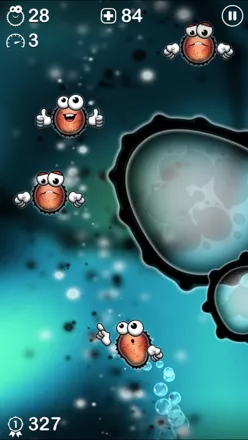 Neil Casini:
Yes, Light Pillar is first and foremost a developer of utilities
but that’s because they are easier and faster to write when there is only two of
you. A game can need animation, voice acting, sound and music; all of
which Gareth and I can’t produce very easily or very quickly. And to be
honest, it’s been nice to give games a rest and enjoy playing other people’s
creations; when you’ve been crunching on a game for 8 months working 16 hours a
day, the last thing you want to do when you get home is fire up your console!
Neil Casini:
Yes, Light Pillar is first and foremost a developer of utilities
but that’s because they are easier and faster to write when there is only two of
you. A game can need animation, voice acting, sound and music; all of
which Gareth and I can’t produce very easily or very quickly. And to be
honest, it’s been nice to give games a rest and enjoy playing other people’s
creations; when you’ve been crunching on a game for 8 months working 16 hours a
day, the last thing you want to do when you get home is fire up your console!
Having said that, we do have a little game in development that we are using as a
vehicle to learn Apple’s new SpriteKit API. It’s a great little system for
building 2D games with. So, outside of our work commitments, we’ve been
experimenting with SpriteKit and have a game which we are going to release later
in the year. It’s called MikeRobe and it’s centered on a cute
little microbe called Mike. He has to swim through the gloop, rescuing his
buddies and avoiding hazards. In fact there are a few other game modes
that test your skill on different criteria. It’s all
old-school-retro-gaming fun that you can pick up and play with just a few spare
minutes. Initially it will be iPhone-only but it will be completely free
to download and play - no hidden costs or in-app purchases. We’ll be
releasing some information on our Facebook page so if you’re interested, like
our page and we’ll keep you up to date.
Q: Finally, you've been in the industry some 20+ years now, witnessed console gaming go online, seen 3D and Motion Control re-marketed using newer technology, and now Home VR on the horizon yet again. Do you feel we are getting too hung up on the technology and forgetting the fun? We've seen the death of the arcades... where is it all going? Actually IF home VR does take off, would you consider getting into developing games for it? The prospect of a VR version of Dead Space Extraction is just too good to pass up...
Neil Casini:
While I feel extremely privileged to have been a part of the
games industry and have witnessed the birth of some truly great hardware, I do
feel a little jaded after such a long stint. Games were all about the
‘fun’ and now they are about the ‘experience’. As hardware gets more
powerful, these experiences are taking longer and longer to build, requiring
even more and more people to build them. The creative and financial
pressures involved in building a next-gen AAA project are enormous and the
expectations of the gaming community can be even bigger - resulting in
experiences that disappoint. This is probably the main reason there are so
many sequels as it’s a safer investment than an original title. T his has ground
creativity to a halt in the big leagues of gaming, with the most interesting and
‘fun’ games coming from the independents working on mobile platforms.
Right now, mobile seems to be the new future of gaming.
So yes, I do believe we are too hung up on technology but as improvements in
hardware decelerate (PS4 isn’t really as big a jump as PS3 was from PS2 is it?),
we will naturally plateau and maybe we’ll get that standardized platform that
Trip Hawkins once dreamt about. One thing is certain, with all the
headache of different hardware removed from the equation, developers could just
concentrate on the games; which after all, it what it’s all about.